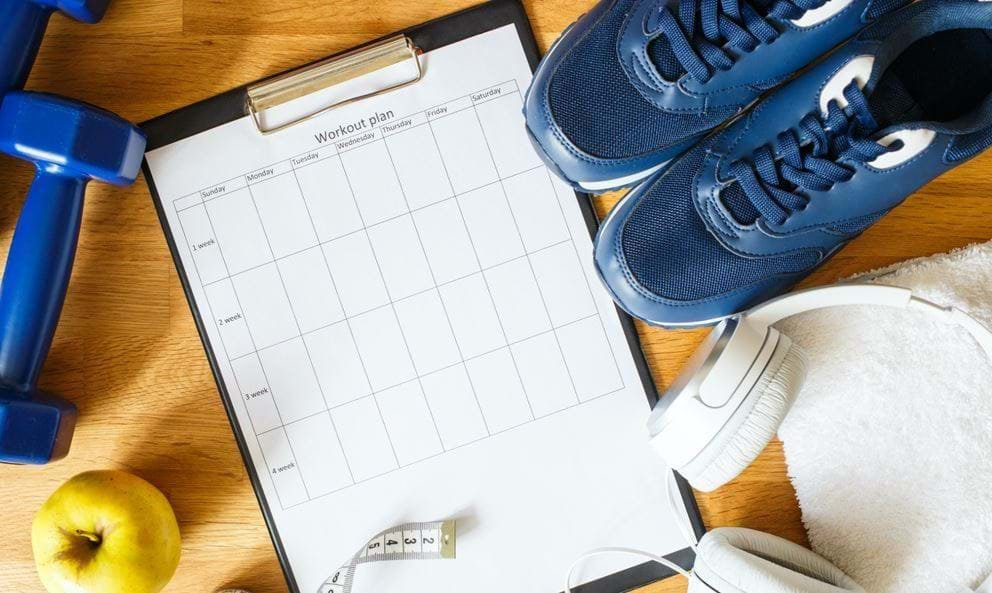How to Plan a Weight Training Program

A good weight training program can really help to focus your workouts and assist you in meeting your goals and objectives. But what is a weight training program and how can you plan one yourself? Read on for more...
What is weight training?
Weight training is a form of strength training that uses weights machines or handheld weights, such as dumbbells, kettlebells or barbells to add a greater challenge to workouts. It offers fantastic benefits such as improved strength and balance, as well as body shaping and weight control.
Read our What is Weight Training and What Are The Benefits guide for more detail.
What is a weight training program?
A weight training program is a plan you make to ensure you're consistently challenging yourself and reaching for your goals as you work out. This can be as simple as written notes to show what types and size of weights you are starting with and how you intend to progress each week or month, or could be a spreadsheet or app on your phone. Ideally, you'll have this with you in the gym to refer to as you exercise; which will also mean you can also mark up any differences between your plans and your actual achievements as you go.
Why is it important to have a weight training program?
Creating and sticking to a weight training program means you're more likely to challenge and drive yourself as you lift, push or pull. You'll be able to set and meet measurable goals and appreciate all the benefits from challenging yourself and your body in a targeted way. It also means you can easily track your progress and enjoy the successes you've achieved.
How to plan a weight training program
So much of creating a weight training program comes down to you - your starting point, your goals, your personal commitment. Whether you're a complete beginner to weight training or have been working out with weights for some time, it's important to have an idea of all of the below when creating your program.
Once you're comfortable that you're ready to get started, you can start filling out your plan. Here's a weight training program template that could serve as a useful starting point.
1. Understand your goals
Why are you focusing on weight training? Is it to build muscle, tone your body or lose weight? Perhaps you'd simply like to feel stronger? Maybe it's to recover or strengthen your muscles after an injury? Or you're keen to focus on strengthening and shaping one particular part of your body. It could be that you're hoping to achieve several of these benefits as you train. Understanding your goals is the first step of creating a program, as this could change how you approach your training. For example, working with heavy weights will help to build muscle mass, while lighter weights over more reps is more likely to help build up endurance.
2. Set short and long term objectives
Once you know what you're hoping to achieve, you can begin to set yourself challenging yet achievable goals to reach. Perhaps you're hoping to lift a certain weight within 3 months, or would like to bulk up to a certain size. Note this down and aim to work backwards from here when planning your expected progress. It could be that you then realise your goal isn't quite achievable in your time frame, so you can rework your program, or maybe you might be on track to meet it sooner than you'd thought. Mapping out your objectives will not only help you gain a better and more realistic picture of how and when you're planning to meet your goals, but it will give you something specific to aim for and successes to celebrate as you achieve them.
Remember, you won't build muscle overnight; it might take some time to meet your objectives. Don't rush yourself and instead enjoy seeing the improvements during your fitness journey.
3. Agree how often you are able to weight train
It's important to be honest about how much time each week you're willing or able to commit to weight training. Are you able to lift every day from Monday to Friday, or is two or three times in the gym each week a little more realistic? It could be that you'll start with fewer days and work your way up to more as your muscles improve. There's no right or wrong answer here (although we recommend factoring in regular rest days to give your body time to recover), it's about being realistic from the start. If you overburden from the beginning and end up missing planned sessions, you could find your confidence takes a knock. Set achievable weekly aims and you'll be more likely to enjoy your accomplishments in a realistic amount of time.
How often you can allocate your training will help to determine how you may want to split your workouts over a week. For example if you want to lift 3 days a week, you may want to organise your workouts so that you do a full body session on Monday, Wednesday and Friday, so that you have a full day to recover in between sessions. However you decide to structure your workouts over a week, we suggest aiming to target each muscle group 2 or 3 times per week, to help you build muscle and get stronger.
4. Find the right starting weight for you
In order to map out your program, you'll need to know where you're starting from. If you've already been training, you should have a good idea of how strong you are and how much weight you're able to lift, push or pull. If you're just starting, it's best to ease your way in and start with lighter weights, and focus on getting your form right, before increasing the weights you use.
If, for example, you're planning on doing 3 sets of 10 reps of any given exercise (a good starting point for beginners), you'll want to finish up the first set feeling a slight challenge but no shaking or major struggle in your muscles. By the end of the third set, you should be feeling a major challenge and should only just be able to complete all of the reps. You should know early on if you've selected a weight that's too heavy (in which case you can stop and adjust to a lighter weight), but it may be that you finish up quite easily - that's okay, you'll know to aim higher next time. If you get it right, this is your starting weight, and you'll be able to plan your program using this as a base.
5. Step up the weights gradually
When creating your program, you'll want to increase weight gradually as you get stronger. Some professionals recommend a maximum increase of 10% of the weight, with the preference being around 5% for upper body, and only when you can comfortably complete two more reps than you have planned, for two separate workouts. You can use your judgement when you find weights are feeling easier and no longer challenging you like they had used to. What you'll find is that when you're new to lifting, progress comes quite quickly, but as you become more experienced and as you get stronger, expect to see slower rate of improvement or even plateaus at times - that's when you can adjust your plan or re-approach your training.
6. Focus on all of the relevant parts of your body
Depending on your objectives, ideally you'll be including all parts of your body in your weight training program. A good approach is to have at least one day per week emphasising upper body work, one focusing one your core and another that focuses on lower body and legs to start of with and working your way up to targeting each muscle group twice per week. Luckily, there's a range of equipment at the gym to help you target different areas, which we've explained here: Lifting Weights: A Guide to Equipment at the Gym. Even if your goal is just to focus on one particular body area, such as the shoulders or glutes, it's still worth including other exercises into your workout routine to avoid muscle imbalances.
7. Revisit your plan
Your weight training program is just that, yours. Setting an eight week plan with a short term goal is a great starting point. When you're nearing the end of that, you can then review your progress and plan for the next eight weeks. Also, your program isn't set in stone - perhaps you were ill, missed a week and your progress is behind; that's no problem at all, just rework your plan to reflect your current progress. While it's good to set goals and objectives to work towards, it's important to find your own pace, which may take a little while to learn and settle into.
Good luck getting started with your weight training program - hopefully these tips will give you the perfect foundation. For an idea of what yo could do at the gym, check out this example workout plan for gaining muscle.
If you're still feeling a little unsure how to get started, or would like help learning more about the weights equipment at the gym, book in a session with one of our Personal Trainers who will be able to support you as you get going. You'll also be able to find tailored plans based on your goals, fitness levels and weekly workout schedule on the free PureGym app, so if you're not sure how to make your own program, this could be an excellent starting point.


